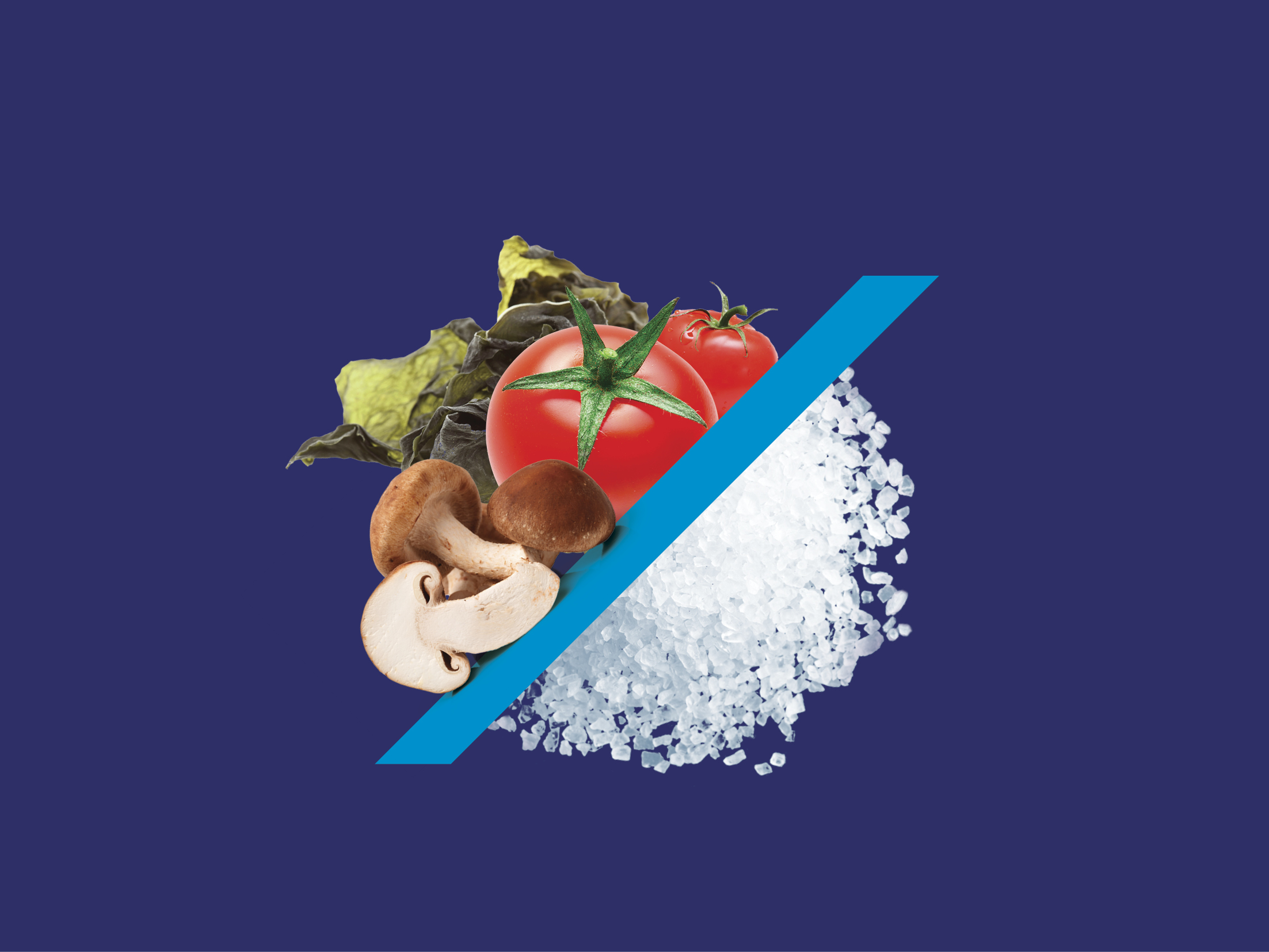What is Umami? And the relation between Salt, Salt Reduction and Umami

Umami The sense of flavor – When we eat, we sense the taste of food. Each food can be recognized due to its flavor characteristics; taste and smell. This sensory perception is linked to the foods’ chemical molecules which stimulate special receptor and channel sites in the human oral and nasal cavities. This stimulation causes the nerves to dispatch messages to the brain recognizing the type of taste, flavor and therefore the type of foods.
The human brain is able to distinguish between 5 basic tastes:
Bitter – associated with chocolate, caffeine, coffee, beer, etc.
Sweet – associated with sugars, candies, sweeteners, polyalcohols, etc.
Sour – associated with vinegar, citric acid, citrus fruit, fermented products etc.
Salty – associated with salt (sodium chloride), mineral salts.
Umami – associated with proteins and amino acids such as glutamate, nucleotides that are found in cheese, mushrooms, tomatoes, etc.
Definition of umami – The sensation of taste and flavor enhancement, especially in the initial stage of stimulation of the brain, is not completely understood by science.
Kikunae Ikeda, a Japanese scientist in the early 20th century, investigated the relationship and contribution of certain molecules to flavor enhancement of savory foods. He found that certain foods has a different taste then the known and recognized 4 basic tastes (bitter, sweet, salty, sour) and he called it “Umami” which is the means ‘Tasty’ or ‘Delicious’ in Japanese. Ikeda also found that these components–especially the amino acid glutamate–have an interaction with other savory foods and improve their palatability.
During the following years, researchers have discovered specific receptors for umami in the tongue: T1R1 and T1R3. It was also found that glutamate can activate mGluR1 and mGluR4 receptors which are located in the central nervous system. Therefore, umami has been recognized by the science as the fifth taste.
Umami components and foods rich with umami – Umami is found naturally in foods such as soy sauce, fish, cheese, mushrooms, seaweeds and vegetables such as tomato, corn, potatoes and peas.
There are several umami components which can be added to food in order to enhance its flavor and make it more palatable: monosodium glutamate (MSG), free amino acids and nucleotides: IMP, GMP, AMP, hydrolyzed vegetable proteins (HVP) and yeast extracts.
Most of these components are synthetically processed and have negative reputation with consumers.
The relation between salt, salt reduction and umami – Salt (sodium chloride) is widely use in the food industry, mainly for taste, as a functional ingredient and as a flavor enhancer. The food industry increased the use of salt due to these functionalities and its low cost.
Although the human body needs sodium to exist, the consumption of salt is far above the recommended level of 2,300 mg/day (6 gr of salt/day). Over consumption of salt can lead to increase in blood pressure which causes cardiovascular and other chronic diseases. Most of the daily salt over-consumption is from processed food.
Accordingly, governments are pushing the food industry via increased regulation to reduce the salt level in their products. There are several solutions for salt reduction:
- Gradual reduction
- Optimization of salt crystal size
- The use of mineral salts
- The use of spice combinations
- The use of flavors
- The use of flavor enhancers
Many of these solutions do not comply with the industry demand for taste, clean label declaration, cost and functionality.
Umami, like salt, is used in foods as a flavor enhancer. Therefore, a certain amount of salt can be reduced when using umami compounds. For example, the taste of chicken soup with 1% salt has an acceptable taste, but reducing the salt content to 0.6% will dramatically negatively affect its palatability. Adding 0.2-0.4% of umami components to the lower salt soup will enhance its palatability and make it acceptable to consumers.
Mediterranean Umami – the natural way to reduce sodium and to enhance flavor –
Salt of the Earth has recently introduced an ingredient called Mediterranean Umami which is prepared from natural sources very rich in umami compounds such as tomato, mushroom and seaweed extracts, combining them with sea-salt.
Mediterranean Umami is our clean-label solution to replace common flavor enhancers already used by the food industry such as MSG, yeast extracts, HVP etc. A significant amount of salt — 25-45% — can be reduced from foods without changing their savory profile.
Ehud Zach,
Food Technologies and Application Manager,
Recommanded Articles
Demand for Comfort Food Creates New Opportunities
Enhancing savory, umami flavors while cutting salt is easier than ever
Read MoreNew Mediterranean Umami Powder Cuts Salt in Snacks
New Mediterranean Umami Powder Cuts Salt in Snacks
Read MoreSalt of the Earth Creates a More Craveable Mac...
Salt of the Earth Creates a More Craveable Mac ‘n’ Cheese
Read MoreMediterranean Umami meets the diverse demands of key global...
Mediterranean Umami meets the diverse demands of key global markets
Read More



